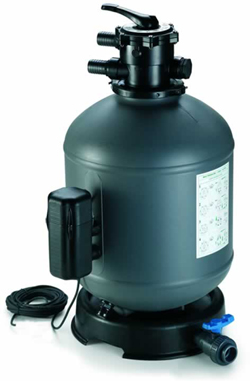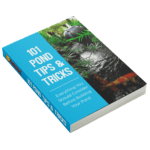There are simply a lot of pond filter systems available on the market today. One could easily get lost in the sea of products. The best way to try and figure out which filter you need, would be to look at the different way water is filtered and then look at the different products that actually do the filtering.
If one were to break down the different types of filtration that is done to water it might look something like this:
- Biological Filtration – This is the actual bacteria colony that your pond builds in order to consume varying waste products produced by aquatic life. In essence these bacteria will consume waste and convert it into less harmful waste that aquatic plants will actually thrive on.
- Mechanical Filtration – This is the process by which large debris is removed from the pond water. Debris such as large fish waste, leaves, old food and such are all caught and strained from the pond water itself.
- Chemical Filtration – This is how chemical toxins are removed from the pond water. Pesticides, organic wastes, proteins and the like removed by agents such as carbon or processes like deionization.
From that standpoint, it is important to know what the filter you plan to purchase will actually accomplish. A filter that manages only mechanical filtration for instance, will only handle a portion of the load your pond produces.
Let’s take a look at some of the filtration styles available today.
 Nexus Filtration – This type of filtration utilizes either a pump fed or gravity fed water supply from the pond to both mechanically and biologically filter the water. The water moves through the first chamber where solids are mechanically removed from the water.
Nexus Filtration – This type of filtration utilizes either a pump fed or gravity fed water supply from the pond to both mechanically and biologically filter the water. The water moves through the first chamber where solids are mechanically removed from the water.
The water then passes to a biological filtration system that uses air to constantly agitate the filter media. This agitation is an important part of ensuring that the filter media does not clump together. If the media clumps together, the water will not effectively filter through it.
Once the water moves from the biological filter, it is run through another mechanical filtration section where even smaller particles are removed. Upon completing this cycle, the water is returned to the pond.
This filter requires weekly maintenance at a minimum and during high feed times will require daily maintenance.
 Vortex Filters – Vortex filters look just what they sound like. They are large, almost conical containers that will rotate the incoming water into a vortex that allows solid matter to settle. The water is pushed into a second chamber where more settling is allowed to occur.
Vortex Filters – Vortex filters look just what they sound like. They are large, almost conical containers that will rotate the incoming water into a vortex that allows solid matter to settle. The water is pushed into a second chamber where more settling is allowed to occur.
These two settling actions are the mechanical filtration process. Depending upon the size of the pond, any number of chambers may actually be needed; sometimes two, three or four chambers. The water is then sent through a biological filtration process at this time to complete the process.
After the biological stage is complete, a pump is usually used to pull water from the final chamber where it is sent back to the pond.
Vortex filters need regular maintenance about every week. The maintenance is simple, where valves are opened and solid waste is drained from each chamber.
 Bead Filters – Bead filters provide a mechanical and biological filter system in one unit. Water is pumped into the bead filter body where it fills from the bottom up. Small beads located inside the body of the filter float on top of the water.
Bead Filters – Bead filters provide a mechanical and biological filter system in one unit. Water is pumped into the bead filter body where it fills from the bottom up. Small beads located inside the body of the filter float on top of the water.
As the water passes through the beads, the solid waste is left on the bottom of the bead layer. Biological filtration takes place within the beads where bacterial colonies will collect and filter the remaining water as it passes through the system.
After passing through the system, the water is returned to the pond. These filters also require some maintenance. It is recommended that the solid waste be flushed from the system anywhere from once per week to once per month.
Some bead filters come with an air blower system that is used during the regular maintenance. The blower forces air into the body of the filter where the air breaks up the beads so that they do not become a solid mass. Remember, a solid mass is unlikely to filter the water properly
 Pressurized Filters – These filters are generally smaller and more compact in size. This makes them easy to hide and you can actually bury them almost completely in doing so. Most people would look at these filters and wonder how something that small can actually filter a pond like any of the larger filters described above.
Pressurized Filters – These filters are generally smaller and more compact in size. This makes them easy to hide and you can actually bury them almost completely in doing so. Most people would look at these filters and wonder how something that small can actually filter a pond like any of the larger filters described above.
The answer is in the turbulence placed around the filter media inside that filter that is caused by the pressurized water flow. More turbulence means more waste (food for the bacteria) and dissolved oxygen gets placed against the filter media. This is why biological filtration of this sort is so much higher than un-pressurized systems.
It is important to remember that typical pumps do not supply the amount of flow that these filters require and choosing the right pump is essential. You should also keep in mind that their smaller size means more cleaning during the maintenance cycles. The more fish you have, the more waste will block the initial filers in this style of filter.
There are some of the types of filters available on the market today. You should make sure that when you shop for a filter, you give the retailer as much information about your pond as possible. This way they can help you get set up with the correct filtration for your pond.


